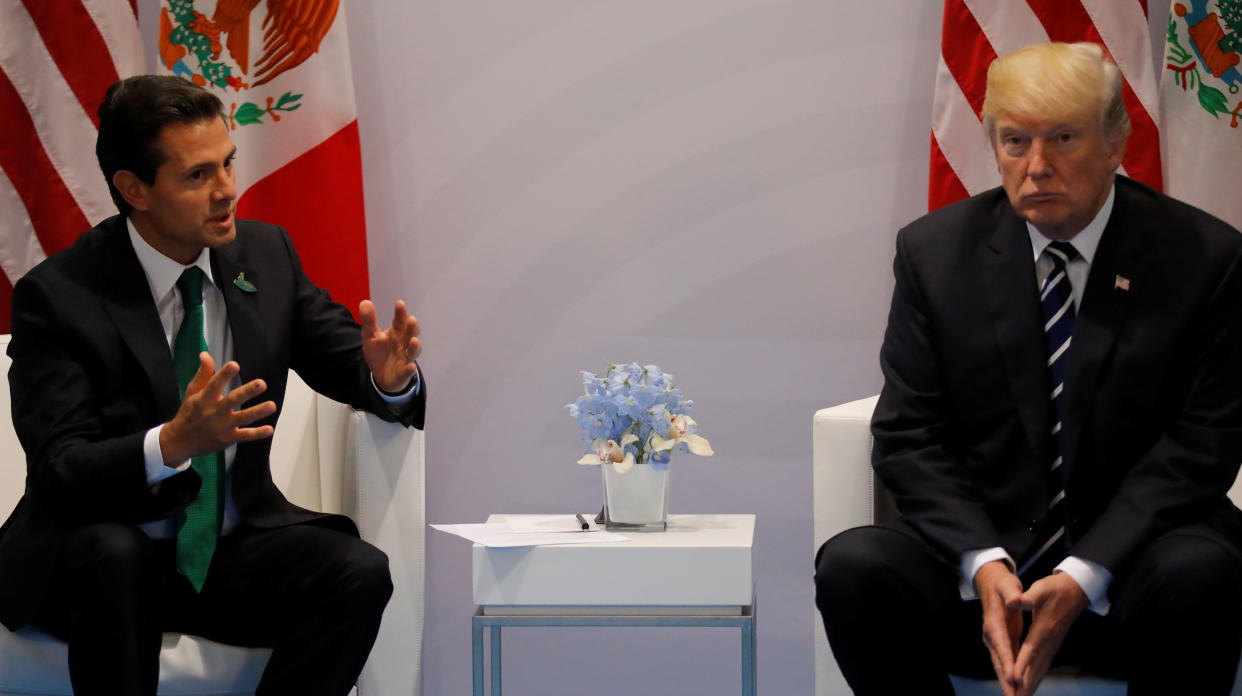What a withdrawal from NAFTA could mean for the economy and markets

Rumors are swirling that President Donald Trump could announce that the United States is pulling out of the North American Free Trade Agreement (NAFTA) during his State of the Union address on Tuesday.
As a candidate, Trump called the trade agreement “the worst deal ever” for the U.S., and since his administration began negotiating the deal in August, both sides remain divided. Given Trump’s penchant for the unconventional—and for policies that provide short-term upside and potential long-term pitfalls—some experts say they wouldn’t be surprised if he shred the accord. But what would that mean for the economy and markets?
Exports to Mexico represent about 1% of U.S. GDP
Trade has increased sharply between the United States and Mexico since NAFTA’s signing, from roughly $290 billion in 1993 to more than $1.1 trillion in 2016. That compares to the $650 billion in bilateral trade the U.S. did with China last year, Deutsche Bank analysts note.
Cross-border investment has also surged during the period, with U.S. foreign direct investment in Mexico rising during that time from $15 billion to more than $100 billion.
However, those numbers are still relatively small potatoes in the big picture. Analysts from Goldman Sachs noted that “exports to Mexico account for just 1% of U.S. GDP. Similarly, revenues to Mexico and Latin America total just 3% of S&P 500 sales.”
“From a macro perspective, withdrawal from NAFTA would likely pose a minor risk to overall US economic growth and corporate profits. US-Canada trade would likely be covered under a prior free trade agreement,” Goldman Sachs’ David Kostin said.
The effects of pulling out of NAFTA probably would not be felt immediately, some analysts say, though the stock market and the countries’ respective currencies would likely suffer. Additionally, it could stoke fears that Trump plans to enact the protectionist and insular policies he touted on the campaign trail—and worried many economists.
Goldman Sachs notes that since Election Day 2016, S&P 500 auto component companies have returned 52% and electronic equipment firms have returned 51%, compared with 36% for the S&P 500 in aggregate. Having raced ahead of the market, those shares could fall far and fast if NAFTA is no more, the analysts warn.
“It’s hard for me to think that the reaction in U.S. risk markets would be positive, because if you’ve looked at surveys from economists, one of the biggest fears has been of a trade war,” said Guy LeBas, chief fixed income strategist at Janney Montgomery Scott, LLC. “I’d have to imagine there would be a risk-off theme [in markets].”
Pulling out of NAFTA would likely also boost inflation, causing the Federal Reserve to quicken its pace of monetary policy tightening and perhaps choking off the market’s growth with a decline in U.S. Treasury yields and 5% drop in the S&P 500 (^GSPC), analysts from Oxford Economics warned in a note to clients. They also expect it to lead to a reduction of half a percentage point off U.S. gross domestic product growth in 2019. Significant impacts likely would not be felt for years, however.
“Academic estimates have suggested that effect of NAFTA has added 0.1 – 0.2% GDP growth a year,” LeBas said. “Over 20 years that’s massive, but over a year or two that’s kind of a rounding error.”
14 million jobs at stake
NAFTA proponents estimate that 14 million jobs rely on the accord and that the jobs it has created pay better than those that have been lost. NAFTA also disproportionately benefits certain businesses, most notably the automobile and agriculture industries, which boast strong lobbies.
The Congressional Research Service found that In the years since NAFTA was signed into law in 1993, U.S. trade with Canada and Mexico has more than tripled, growing more rapidly than trade with the rest of the world.
“Canada and Mexico are the two largest destinations for U.S. exports, accounting for more than a third of the total,” the report states. “Most estimates conclude that the deal had a modest but positive impact on U.S. GDP.”
Leverage to negotiate
However, NAFTA has had a bigger impact on the economies of U.S. neighbors. While it represents fractions of the U.S. economy, trade overall and NAFTA specifically represent substantial portions of Mexico and Canada’s GDP.
That’s likely why President Trump feels he’s got so much leverage to negotiate.
The uncertainty about NAFTA and other protectionist measures in Trump’s crosshairs are one of the few negatives weighing on market sentiment since the presidential election.
“For the short-term economic projections we’re basically assuming that the uncertainty of negotiations is slowing down the economic growth of the nations involved,” said Alejandro Werner, the International Monetary Fund’s Director of the Western Hemisphere Department, last week in a forum at New York’s America’s Center.
Werner expects the United States to retain NAFTA, but like many who study the global economy, wonders what a future without NAFTA would entail.
“It’s very hard to think what will be that alternative scenario,” he said.
—
Dion Rabouin is a markets reporter for Yahoo Finance. Follow him on Twitter: @DionRabouin.
Follow Yahoo Finance on Facebook, Twitter, Instagram, and LinkedIn.


